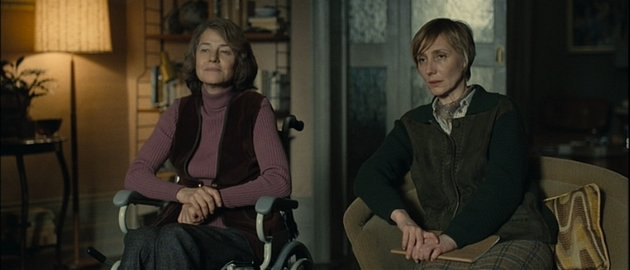The Curious Incident of the Dog In The Night-Time
Review of Encore Performance at NYU Skirball Center, October 26, 2012.
Not cinematic rendition but video documentation of the play, as performed in the National Theatre in the UK. The performance was staged in the round, with innovative special and sound effects and minimal props and sets. These included several unadorned multi-use moveable pedestals (these cost-effective but minimalist items were not only used as seats, but as escalator steps, a train interior, luggage, and, in one instance, with appropriately-timed sound effects along with a performance best left to the imagination, a toilet.
The stage was divided into grids, finished with blackboard paint (this was crucial, because among other things, Christopher used it to draw a chalk outline of the dead dog, which he quickly surrounded by a mind-map of the crime as he saw it). The stage surface, studded with tiny LED lights, was a large and more technically sophisticated light-brite, which made possible the flexibility of the staging, meaning the story could quickly switch from Christopher’s walk around the neighborhood, with the footprints of neighbors’ houses drawn in white light for Christopher to walk past, to his time at school, and various rooms in his home.
This unique stage also provided the perfect means for displaying the complicated algebra and geometry problem which got him his top score on the math A-levels, a faithfulness to the book and the style of the narrative which might not have otherwise been possible. Given the nature of the book, a complex internal narrative from the point of view of an autistic teen whose world has been limited, and whose sensory issues make such crowded, noisy, and distracting places as train stations more frightening and difficult for him to navigate than for neurotypical persons, I was not the only one who wondered how this deep and silent internal narrative could be translated to words and actions effective for the purposes of the theatre.
Neither those who valued adherence to the book nor those who were assessing the dramatic performance immediately in front of them (effectively presented upon a larger than average, square, rather than rectangular, screen) were disappointed. The other characters all have a say in Christopher’s internal monologue, and their sometimes conflicting influences add to his sensory and emotional overload. His father’s discouragements and criticisms echo in his head, as well as his more positive talk. Beloved teacher Siobhean, who is also effectively a social worker/counselor to him, is seen as a Jimminy Cricket to his Pinnochio.
Other characters begin their parts, but then repeat themselves or revise their actions, depending on Christopher’s re-telling of the story, and re-stating of the details. A moment of levity ensues when a police officer steps into the scene, and then is described as a different police officer from the one who had been on the train with Christopher previously. He hands off his police hat and vest to a different man in police uniform, who steps onto the stage and continues the scene, the edges of the stage being the borders of Christopher’s mental picture-making.
Prior to the showing of the play itself, the theatre presented a making-of-the-production featurette which showed various aspects of the staging and rehearsals. Revealed in this movie about the movie about the play was the fact that in order to realistically present in performance the behavior of Christopher and of the people he encounters, they utilized the services of an autism consultant who was, herself, on the spectrum. She used the opportunity to comment on the perception that autistic people lack imagination. This overgeneralization is not quite accurate. While they might not be able to accurately guess others’ motives in social situations, the ability to generate original imagery and ideas remains.
After the show, Stephen Yoffe wheeled out on stage to lead the discussion of various aspects of the show, among them the fact that the play ended on an ambiguous note. Christopher, his self-confidence boosted by having solved the mystery, successfully taken the train to London, and evaded the police, saying he could “do anything”, with a questioning tone at the end of the statement, following a monologue about his future aspirations to take the rest of the A-levels (comprehensive university entry exams), go to university in a less crowded and busy metropolitan area than London, become a scientist, and then an astronaut, after having successfully departed both his parents’ households for a flat of his own and independent adulthood. All his life, he had been told by society as a whole and more immediately and personally, by the authority figures in his own life, that he wasn’t capable of doing certain things. He had to have felt a certain amount of triumph in having successfully torn apart a tissue of lies, evaded the police, and taken the train to London on his own.
Given that the British legal system, school system, and police force are quite different from those in the USA, it is to be noted that Christopher’s story could very well have unfolded quite differently at any point, had it been set in the USA.
It was perhaps deliberately left open-ended as to whether Christopher could or would be successful in these and/or other goals (one audience member suggested that unmentioned and perhaps undervalued in this scenario were “different kinds of success”, such as the future possibility of Christopher successfully making friends, having a relationship, perhaps marrying and having children). The fact that Christopher drew a large face with a smile on the stage floor during the conclusion of the play was viewed as a milestone for Christopher in understanding both the facial expression and the emotion behind it.




